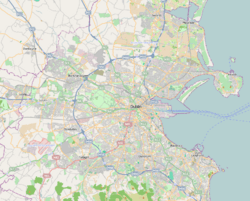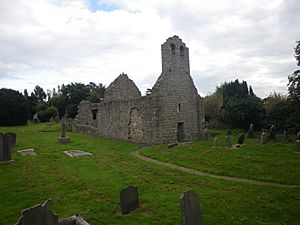Kill of the Grange facts for kids
Quick facts for kids Kill of the Grange |
|
|---|---|
| Kill o' the Grange, Clonken | |
|
Cill na Gráinsí, Cluinchenn
|
|
 |
|
| 53°16′53″N 6°09′40″W / 53.281377°N 6.160982°W | |
| Location | Kill of the Grange, Deansgrange, Blackrock, County Dublin |
| Country | Ireland |
| Denomination | Pre-Reformation Catholic |
| History | |
| Founded | 11th century |
| Architecture | |
| Style | Norman |
| Years built | 11th century |
| Closed | 16th century |
| Specifications | |
| Length | 17 m (56 ft) |
| Width | 7 m (23 ft) |
| Materials | Stone |
| Administration | |
| Diocese | Dublin |
Kill of the Grange is a really old religious place in County Dublin, Ireland. It's so important that it's protected as a National Monument. This means it's a special historical site that helps us learn about the past.
Contents
Where is Kill of the Grange?
Kill of the Grange is located about 1.7 kilometers (just over a mile) away from the coast, on the south side of Dublin Bay. Today, it's surrounded by houses and can be found in Deansgrange, which is part of Blackrock in County Dublin.
What Structures Can You See?
The main building here is an old church. It is connected to a saint named Finnian of Clonard and was built around the 11th century (that's the 1000s!). Some parts might even be older, from the 6th century, because they look similar to ruins found at Glendalough.
The church started as a simple rectangular building. This part is called the nave, which is the main area where people would gather. Later, a chancel (the part of the church near the altar) and a belfry (a tower for bells) were added.
Originally, this place was called Clonkeen (which is Cluinchenn in Irish). Now it's known as Kill of the Grange. "Kill" means "church" and "grange" means a farm or storage area that belonged to a monastery. So, it means "church of the monastic farm."
You can also find a bullaun stone here. This is a special stone with a bowl-shaped hollow, about 25 centimeters (10 inches) across. There is also a holy well on the site, which is a natural spring believed to have special powers.
Modern Churches in the Area
Even though the old church is a ruin, there are two modern churches nearby that are still used today:
- The Church of Ireland Church is close to the traffic lights. It was designed in 1863 by William John Welland and John Gillespie. They were architects for the church. This church was officially opened in 1864.
- The Roman Catholic Church is near Bakers Corner. This Catholic church was built in the 1970s. Some people call it 'The boiler house' because of its unique design. It's known for how it uses light coming from above.
Historic Houses Nearby
The area around Kill of the Grange has many old houses. One of them is called Kill Abbey. It was first built in 1595 by a person named John Usher. The house has been changed a lot over the years, but it is still the oldest house in the Dun Laoghaire Rathdown area.
A Glimpse into the Past
This site used to belong to a group of monks called the Priory of the Holy Trinity. This group later became Christ Church Cathedral, Dublin. Their old records give us a good idea of what life was like at Clonken / Kill o' the Grange in the 1300s.
These records describe how they built a special house for a kiln (a type of oven). This building had a thatched roof (made of straw or reeds) and walls built using wattle and daub (a mix of woven branches and mud). The main farm building, or monastic grange, was built using timber. This wood was bought from the native Irish people, probably from the Dublin Mountains.



